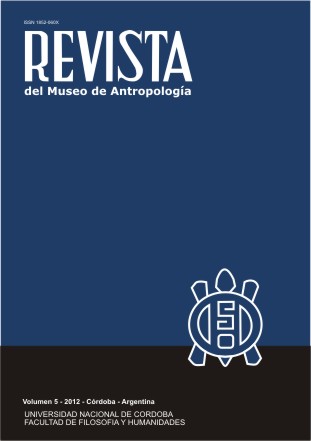Archaeofauna of the archaeological site “El Piñón”, Cultura Bolaños, Jalisco México
DOI:
https://doi.org/10.31048/1852.4826.v5.n1.9140Keywords:
Bolaños Canon, “El Piñón”, shaft tombs, specimenAbstract
The Bolaños culture is made up of many human communities that established in one of the western Sierra Madre canyons, Mexico. Their occupations are chronologically dated between 100 years BC and 1260 years AD, and extended from southern Zacatecas to the mouth of the Rio Grande of Santiago, in the center of Jalisco, Mexico. The basis of their development was the exchange of artifacts for products and raw material that didn’t exist in the western Mexican region. Here, the archaeozoological study performed with the bone remains recovered in excavations from the “El Piñon” archaeological site is presented. Corresponding interpretations allowed to reconstruct the natural and cultural environment. The identified fauna consisted, in a preliminary analysis, consists of 3333 specimens. More than 250 individuals were identified from cremated, burnt or worked bone and teeth, including: rabbit, hears, squirrel, mole, dog, mountain lion, lynx, peccary, deer, turkey, duck, quail, green macaw, among other vertebrates that are common in the semidry-mild weather that prevails in the Zacatecas-Jalisco region.Downloads
References
Aranda Sánchez, S. J. 1980. Los mamíferos de la sierra del Ajusco. Comisión Coordinadora par el Desarrollo Agropecuario del Distrito Federal; DDF, México.
Arrieta Fernández, P. 2004. Mesoamérica: ecología cultural. Perspectivas Latinoamericanas, CIESAS, N° 1: 40-67. México
Blanco Padilla, A. 2003. La guacamaya en el México Prehispánico. Imagen Veterinaria 3 (4): 53-55.
Cabrero García, M. T. 1985. Balance y perspectiva de la arqueología en los estados de Jalisco, Zacatecas y Durango. En Anales de Antropología, Vol. XXII, 13-40. Instituto de Investigaciones Antropológicas, UNAM, México.
Cabrero García, M. T. 1993. Hallazgos recientes en el Cañón de Bolaños, Jalisco. En Anales de Antropología, Vol. 30, 47-72. Instituto de Investigaciones Antropológicas, UNAM, México.
Cabrero García, M. T. 2005. El hombre y sus instrumentos en la cultura Bolaños. Instituto de Investigaciones Antropológicas-UNAM, México.
Cabrero García, M. T. 2010. El hombre y sus instrumentos en la cultura Bolaños II. Instituto de Investigaciones Antropológicas-UNAM, México.
Cabrero García, M. T. y C. López Cruz. 1999. Las tumbas de tiro de “El Piñón” en el cañón de Bolaños, Jalisco. Latin American Antiquity 9 (4): 228-241.
Cabrero García, M. T. y C. López Cruz. 2002. Civilización en el norte de México. Volumen II. Instituto de Investigaciones Antropológicas-UNAM, México
Chaix, L. y P. Méniel. 2001. Manual de arqueozoología. [Revisión técnica y prólogo: Jordi Nadal Lorenzo]; Universitat de Barcelona, España.
Kan, M.; C. Meighan y H.B. Nicholson. 1970. Sculpture of Ancient west México: Nayarit-Jalisco-Colima. The Protector Starford Collection, Museum of Art, Los Angeles USA. Kirchhoff, P. 1943. Mesoamérica. Acta Americana I: 92-107.
López Austin, A. 1967. Juego rituales aztecas. Instituto de Investigaciones Antropológicas/Universidad Nacional Autónoma de México, México.
Matos Moctezuma, E. 1994. Mesoamérica. En Historia antigua de México. Volumen I. El México antiguo, sus áreas culturales, los orígenes y el horizonte Preclásico, pp. 49-63, coordinado por L. Manzanilla y L. López Lujan.
INAH, UNAM, Miguel Ángel Porrua Editores, México, D.F. Montemayor, C. (coordinador) (2007). Diccionario del Náhuatl en el español de México. UNAM, Programa Universitario de México Nación Multicultural, Coordinación de Humanidades, Secretaria de Educación del Distrito Federal, México.
Padró Irizarry, J. 2002. La industria del hueso trabajado en Teotihuacan. Tesis Doctoral Inédita. Universidad Nacional Autónoma de México, México.
Pérez Roldan, G. 2005. El estudio de la industria del hueso trabajado: Xalla, un caso teotihuacano. Tesis para obtener el grado de licenciado en arqueología, E.NA.H., S.E.P., México.
Rodríguez Galicia, B. 2010. Captura, preparación y uso diferencial de la ictiofauna encontrada en el sitio arqueológico de Teopancazco, Teotihuacan. Tesis de doctorado en antropología. Facultad de Filosofía y Letras/Instituto de Investigaciones Antropológicas. UNAM, México.
Rodríguez Galicia, B., R. Valadez Azúa; G. Pereyra; F. Viniegra Rodríguez; K. Olmos Rodríguez y A. Blanco Padilla. 2001. Restos arqueozoológicos de perros (Canis familiaris) encontrados en el sitio de Guadalupe, Estado de Michoacán. AMMVEPE 12 (6): 199-209.
Sahagún, B. 1979. Códice Florentino. Vol. III (Libro XI), Secretaria de Gobernación, México.
Valadez Azúa, R. 2009. El perro en el sitio arqueológico de Pochotitán, Jalisco. AMMVEPE 20 (4): 85-94.
Von Winning, H. 1972. Anecdotal Scalpure of Ancient west México. The Ethnic Arts Counsil of Los Angeles, USA.
Downloads
Published
Issue
Section
License
Those authors who have publications with this Journalaccept the following terms:
a. Authors will retain their copyrights and guarantee the journal the right of first publication of their work, which will be simultaneously subject to the Creative Commons Attribution License (Licencia de reconocimiento de Creative Commons) that allows third parties to share the work as long as its author and his first publication in this journal.
b. Authors may adopt other non-exclusive licensing agreements for the distribution of the version of the published work (eg, deposit it in an institutional electronic file or publish it in a monographic volume) provided that the initial publication in this journal is indicated.
c. Authors are allowed and recommended to disseminate their work on the Internet (eg in institutional telematic archives or on their website) before and during the submission process, which can lead to interesting exchanges and increase citations of the published work. (See The Effect of Open Access - El efecto del acceso abierto)












